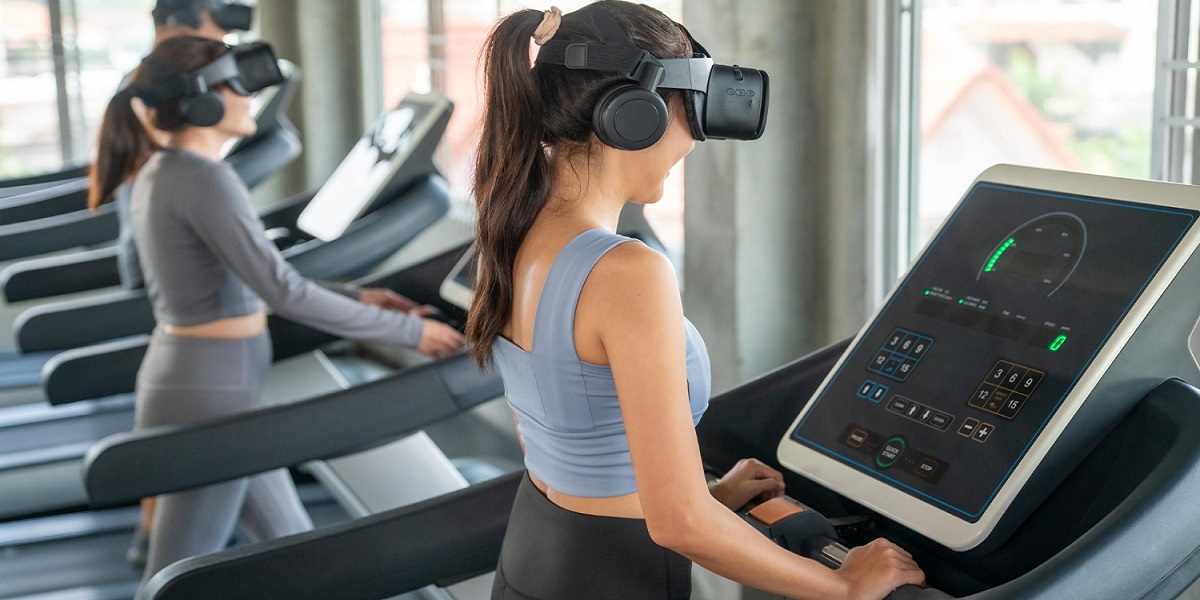
12 Technology Innovations Transforming Sports Facilities in 2025
- By Olivia Rose
- 11-09-2025
- Technology
Sports facilities are evolving rapidly in 2025, with technology driving major transformations. From gyms to stadiums, innovations are enhancing operations, improving user experiences, and solving long-standing challenges.
These technologies don’t just streamline management or save costs - they actively improve how people engage with the facility itself.
Whether it’s through smarter security systems or tools that personalize workouts, every advancement has practical benefits.
This article explores twelve key technologies reshaping sports spaces today. So, let’s dive into the game-changing solutions taking over the industry.
1. Artificial Intelligence
Artificial intelligence (which seems to be taking over the world lately! - but not in a bad way) is reshaping sports facilities by enhancing operational efficiency and decision-making.
Through advanced algorithms, AI systems analyze data to do things like predict equipment maintenance needs, improve crowd management, and streamline operations.
For example:
- Predictive analytics flag potential failures in HVAC or lighting systems before breakdowns occur.
- AI-driven video surveillance improves security by identifying unusual activity patterns in real time.
- Automated scheduling optimizes facility usage based on historical attendance trends.
Facilities leveraging AI reduce costs while maintaining peak functionality. By predicting maintenance issues early, expensive disruptions are minimized, and user satisfaction improves significantly.
2. Biometric Access Systems
Biometric access systems (which you’ve probably heard of) are rapidly revolutionizing how sports facilities manage security and entry.
If you’re not aware, these awesome systems use unique physical characteristics, such as fingerprints, facial recognition, or retina scans, to grant or deny access.
They eliminate the need for physical tickets or ID cards. Facility managers, whether at local gyms or large sports venues, can implement touchless entry points for smoother crowd flow. They reduce unauthorized access by verifying identities in real time with high accuracy.
For athletes and staff areas, biometric locks provide secure zones without requiring traditional keys or codes that can be shared or stolen.
At large venues, spectators benefit from faster entry lines at games and events.
This technology not only heightens security but also improves convenience and operational efficiency within sports venues. By streamlining entry processes while safeguarding sensitive spaces, it enhances the experience for all users involved.
3. Sustainable Energy Solutions
Sustainable energy solutions are revolutionizing how sports facilities manage their environmental impact. These technologies prioritize efficiency and renewable energy sources (which are becoming all the rage - and with good reason) to reduce operational costs and carbon footprints.
Examples include:
- Solar panels - which can be used to power lighting, heating, or even scoreboards in stadiums. (Yes, they’ve been around for some time - but they’re still one of the best sustainable energy solutions out there.)
- Wind turbines - which can be installed on-site to provide clean energy for large venues.
- Energy-efficient LED lights - which can replace traditional fixtures, significantly lowering electricity use.
- Smart grid systems - which can monitor consumption and optimize power distribution during peak events.
Stadiums benefit by offsetting their substantial energy demands with renewable alternatives like solar or wind installations.
Smaller facilities, such as gyms, can adopt efficient LED lighting to cut expenses while maintaining well-lit spaces for members.
Integrating sustainable practices (which, surely, we should all be doing these days) enhances a facility's eco-friendly reputation, appeals to environmentally conscious patrons, and delivers long-term savings on utility bills - all without compromising functionality or performance quality for users at any level of activity.
4. IoT Devices
Internet of Things (IoT) devices connect sports facilities to a network of smart systems, enabling real-time monitoring and control.
These tools are widely used in large venues like stadiums and arenas but also hold potential for smaller spaces such as fitness centers or training complexes.
In stadiums, they can monitor seating occupancy during events to optimize staffing and resource allocation.
For gyms or training centers, IoT equipment can track energy use across machines like treadmills or ellipticals (and you should give the letter a try if you haven’t already done so - ellipticals are great for providing full-body workouts), ensuring optimal performance while identifying maintenance needs early.
These interconnected systems allow managers to reduce costs through efficient resource management.
5. Smart Turf Technology
Smart turf technology is changing the game (no pun intended - well, maybe it was) for sports fields and outdoor facilities - by integrating advanced materials and monitoring systems.
These innovations enhance playing surfaces, thus ensuring:
- Safety.
- Performance.
- Sustainability.
Examples include the following:
- Turf equipped with embedded sensors (who would’ve thought such a thing was possible only a few decades ago!) tracks usage patterns and wear areas to guide maintenance schedules.
- Advanced drainage systems prevent waterlogging, keeping fields playable in all weather conditions.
- Temperature-regulating materials reduce surface heat on artificial turf during hot seasons.
- Recyclable components make synthetic turfs more environmentally friendly (which is so important these days, right?) at the end of their lifespan.
These features benefit large stadiums hosting high-profile matches as well as smaller community or training grounds that need durable yet safe surfaces for daily use.
By adopting smart turf solutions, facility managers improve field quality while reducing maintenance costs and environmental impact - delivering a better experience for both athletes and staff alike.
6. Virtual Reality
Virtual reality (VR) is transforming sports facilities by enhancing experiences for both fans and athletes. This technology creates immersive environments using headsets and motion-tracking devices, offering innovative ways to interact with the space.
In stadiums, VR provides virtual seating previews, allowing fans to select the best view before purchasing tickets.
Some venues even offer VR fan zones where spectators can relive iconic moments or experience a game from a player's perspective.
For gyms or training centers, VR introduces engaging workout programs that simulate activities like hiking trails or boxing matches (just think - you don’t need hiking boots or boxing gloves!). It also supports athlete training by replicating in-game scenarios for practice without physical risks.
By adopting VR, facilities can improve engagement through interactive features while fostering creative new revenue streams.
Whether it's making workouts more exciting at gyms or enriching spectator experiences at arenas, this tech pushes boundaries in meaningful ways.
7. Digital Membership Solutions
Digital membership solutions are transforming how gyms and fitness centers manage their members. These platforms streamline processes for both staff and users, offering intuitive tools to handle memberships effectively.
Key features include the following:
- Online sign-ups and renewals let new members join or existing ones extend plans without visiting in person (so, you can sign up anytime and anyplace).
- Integrated payment systems ensure quick and secure processing of subscription fees or add-ons like personal training sessions (which you might like to consider if you have trouble sticking to goals).
- Member portals provide access to schedules, class bookings, and progress tracking at any time.
- Customizable plans allow facilities to offer tiered memberships tailored to different needs.
These solutions simplify administrative work for gym owners while improving member satisfaction through accessibility and transparency.
By making memberships easy to manage online or via apps, facilities can focus on delivering great workouts instead of dealing with paperwork or manual record-keeping.
8. Studio Management Software
Studio management software simplifies how sports facilities handle programs like fitness training, personal coaching, or skill development workshops.
Tailored to meet the unique needs of the industry, studio management software like Studio Director makes scheduling, registration, and administrative tasks much easier for coaches, managers, and gym owners.
Many platforms automate reminders for participants about studio sessions or upcoming renewals to reduce no-shows.
Integrated payment systems allow easy processing of membership fees or session bookings without manual intervention.
Customizable tools help track attendance and progress for group activities like martial arts or swim lessons.
This type of software saves time by streamlining tedious tasks while enhancing organization across various program offerings in gyms or specialized training centers.
Coaches and staff can focus more on delivering quality experiences rather than managing paperwork or logistics manually.
10. Smart Locker Technology
Smart locker technology is modernizing storage solutions in gyms and fitness centers. These systems go beyond basic locking mechanisms, offering features that enhance:
- Convenience.
- Security.
- User experience.
Here’s how they’re making a difference:
- Lockers equipped with digital keypads or mobile app integration allow members to access their storage without carrying physical keys.
- Real-time availability tracking lets users find open lockers quickly during busy hours.
- Customizable time limits help facilities optimize locker turnover and reduce misuse.
- Some systems even provide charging ports for devices like phones or wearables while stored.
For gym owners and managers, smart lockers simplify operations by reducing lost key incidents and improving overall space efficiency.
Members benefit from added convenience and advanced functionality, creating a more seamless experience every time they visit the facility.
10. Interactive Workout Displays
Interactive workout displays are bringing a new level of engagement to gyms and fitness centers. These high-tech screens provide real-time guidance, feedback, and entertainment (which is great for keeping you focused) during exercise sessions.
They offer several practical uses. For instance:
- Touchscreen displays on cardio machines show customized workout programs tailored to individual fitness goals.
- Virtual trainers deliver step-by-step instructions for strength training or functional workouts in group settings.
- Progress tracking systems display stats like heart rate, calories burned, or the distance covered while exercising.
- Entertainment options keep users engaged with music videos, streaming apps, or interactive games tied to their performance.
For gym-goers, these systems create a more motivating environment that blends fitness with technology-driven support.
For facility managers, they add value by modernizing equipment offerings and enhancing the overall member experience - making workouts both efficient and enjoyable for all participants.
11. Augmented Reality
Augmented reality (AR) is revolutionizing fitness training by overlaying digital visuals and information onto the physical environment.
This cutting-edge technology enhances workout experiences in gyms and fitness centers through a variety of applications.
For example:
- AR mirrors guide users through proper exercise form by providing real-time visual feedback (how cool is that?).
- Immersive group classes use AR projections to create dynamic and engaging environments for workouts like cycling or yoga.
- Personalized workout plans are displayed on AR-enabled glasses or screens, making routines easier to follow.
- Interactive games integrated into exercises motivate participants while keeping sessions fun and challenging (which is a good combination, right?).
This technology appeals to individuals looking for unique, tech-savvy fitness options - while offering an edge over traditional facilities.
By incorporating AR into their spaces, gyms and other sports facilities can create exciting new ways for their users to train effectively and stay engaged with their fitness journeys.
12. Robotics
Robotics (which we’re surely going to see more of over the next decade) is simplifying equipment management in gyms and fitness centers by automating tasks that previously required manual effort.
These systems improve operational efficiency and user convenience in several ways:
- Automated robots sanitize gym equipment, ensuring cleanliness between uses without relying on staff intervention.
- Smart weight racks use robotic arms to reorganize misplaced dumbbells or weights back to their proper positions.
- Equipment-checking systems identify maintenance needs by scanning machines for wear or malfunctions during idle times.
- Some robots even assist with setting up machines or weights, which is especially beneficial for members with mobility challenges.
By integrating robotics into daily operations, gyms maintain a safer, cleaner environment while reducing the burden on staff.
Members benefit from consistently well-maintained spaces where they can focus entirely on their workouts rather than worrying about hygiene or organization issues.
Final Thoughts
The future of sports facilities lies in innovation, where technology and functionality meet to create better experiences for everyone involved.
For users, gyms, venues, and other sports facilities are becoming:
- Smarter.
- Cleaner.
- More engaging environments.
And managers benefit from tools that reduce stress while increasing efficiency across the board.
Recent blog

How AI Is Reshaping Real Estate with Smarter Solutions
Artificial Intelligence | 11-09-2025
12 Technology Innovations Transforming Sports Facilities in 2025
Technology | 11-09-2025




